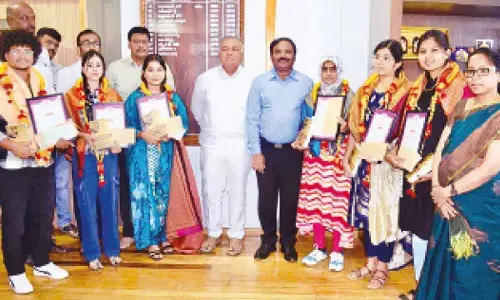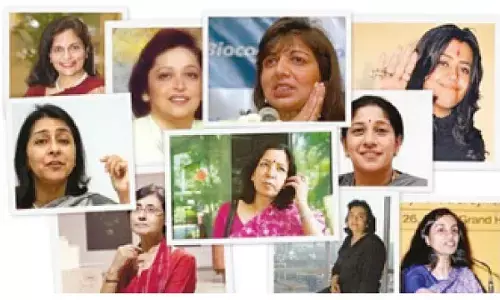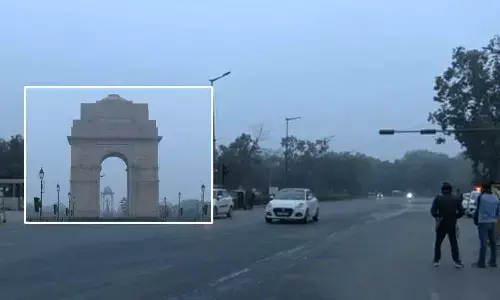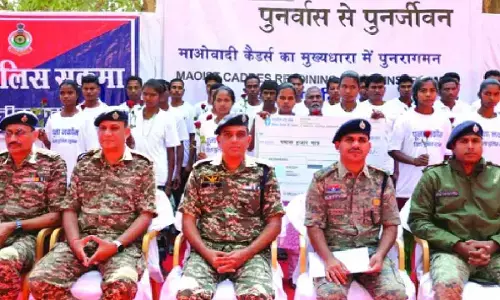Nara Chandrababu Naidu’s SMART governance again
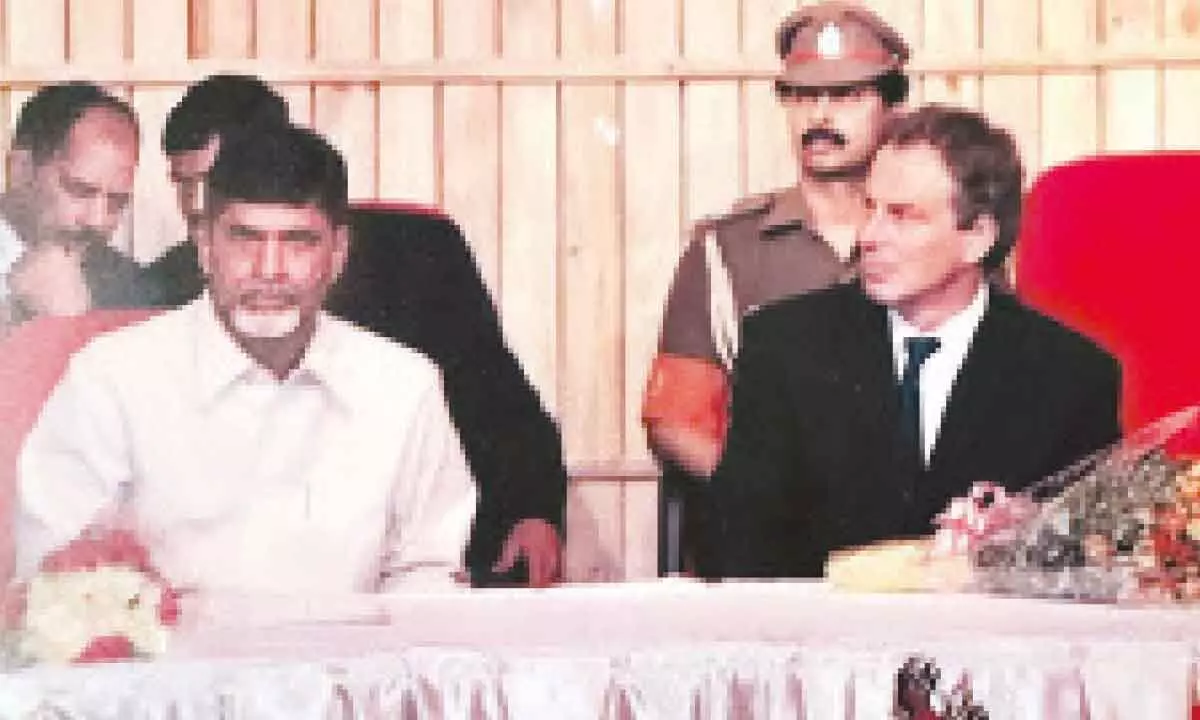
CM Chandrababu Naidu and UK Prime Minister Tony Blair address a meeting after the latter inaugurated Centre for Good Governance (CGG) on the campus of HRD Institute in Hyderabad 2001
Management guru CK Prahalad was all praise for his innovative use of IT in governance
He transformed an orphan like IOA (Institute of Administration), renaming it as Dr MCR HRD Institute after the demise of former CM Channa Reddy, and placing it on top of global training centres. He leveraged Information Technology (IT), initiated e-governance, established e-Seva centers, streamlined government services, and presented good and smart governance and public service delivery facility. His IT initiatives provided incredible opportunities to youth in large numbers in obtaining lucrative employment with better placements abroad, especially in USA
Nara Chandrababu Naidu, on assuming charge as Chief Minister of the present Andhra Pradesh for second time, in a brief meeting with IAS, IPS officers who came to greet him,subtly reprimanded and admonished his predecessor Y S Jagan Mohan Reddy's governance.
Frankly speaking, by being not at all harsh, he established an innovative convention while criticising the previous government. He emphasised that it led to a significant decline in administrative values and ethics, undermining the very integrity and efficiency of officers, including those who perhaps were in service, when he was the CM of erstwhile AP. It was but natural to a person of Chandrababu Naidu’s moral principle to remark so. People familiar with his SMART Governance (Simple, Moral, Accountable, Responsive and Transparent) initiative during his two terms as CM of erstwhile AP will only understand his style.
My 9 years stint as Faculty and Additional Director in Dr Marri Channa Reddy Human Resource Development (MCR HRD) Institute (formerly Institute of Administration or IOA}, provided me an insight and opportunity to observe Chandrababu Naidu demonstrating extraordinary interest, aptitude, and ability with remarkable commitment to SMART Governance, and ‘Systematic Training.’ Supported by DG PVRK Prasad, ADG Urmila Subba Rao etc., he transformed an orphan like IOA, renaming it as Dr MCR HRD Institute after the demise of former CM Channa Reddy, and placing it on top of global training centres. He leveraged Information Technology (IT), initiated e-governance, established e-Seva centers, streamlined government services, and presented good and smart governance and public service delivery facility. His IT initiatives provided incredible opportunities to youth in large numbers in obtaining lucrative employment with better placements abroad, especially in USA.
Chandrababu Naidu apportioned significant time to place strong emphasis on training and capacity building for government employees as per National Training Policy (NTP) guidelines. Once, when I accompanied ADG (IOA Still) Urmila Subbarao with ODA (DFID) delegation in 1996 year end to meet CM Chandrababu Naidu, he shrewdly seized the opportunity to request the delegation to fund IOA in identifying best practices and develop replicable models for Good Governance. Urmila Subbarao drafted initial proposal. Little did we realise then that our meeting would lead to establishment of Centre for Good Governance (CGG) in 2001, in the sprawling campus of HRD Institute, in collaboration with Department for International Development (DFID) and World Bank. UK Prime Minister Tony Blair inaugurated CGG and spent quality time in the campus, including one-to-one meeting in the guest house with the CM.
In a subsequent meeting of ours with him, the CM, approving of ADG Urmila Subbarao’s suggestion, mooted the idea of ‘Training Need Analysis’ of five lakh government employees, through OMR (Optical Mark Reader) sheets, first of its kind, to realise the NTP concept of ‘Training for All’ (TFA). Until then, IOA training was not systematic. Immediately on PVRK assuming charge as HRD Director General (DG), by which time the OMR format based ‘Training Needs Analysis’ was half way through, I accompanied PVRK to meet CM Chandrababu Naidu on receiving a call from him, who despite being busy watching exit polls of Lok Sabha elections, wanted to know about the progress of OMR activity. PVRK who just joined and being not aware of OMR activity, discussed with me the status (ADG Urmila Subbarao was on leave then), and provided details to CM.
That was the genesis for the massive ‘State Training Initiative’ (STI) that not only changed the entire complexion of ‘Capability Building,’ but also, ‘Capacity Building.’ STI was to build capacities of providing at least 60 hours of training to each State government employee. Dr MCR HRD Institute was entrusted with the mandate of developing human resources, to fulfil manpower requirements of State government. Institute’s infrastructural facilities like training rooms, video conference hall, building complex extension to three floors, world class auditorium, guest houses, hostel facilities, Microsoft IT Academy etc., were completed, and brought to the state of the art level. The Institute, transformed into ‘Centre of Excellence,’ has the imprint of Chandrababu Naidu, DG PVRK Prasad and ADG Urmila Subbarao.
Systematic identification of individual, functional and organizational training needs was completed. Training modules including video were developed. District Training Centers were established. Separate Training Budget Head (1.5% of salary budget) was made.
In this context, the saga of Administrative Reforms’ initiative in India, in which Chandrababu Naidu played vital and practical role was motivating. On the threshold of ‘Fifty years of Indian Independence’ a conference of CMs presided over by the then Prime Minister Gujral was held on May 24, 1997. It discussed an action plan for providing ‘Effective and Responsive Government’ ensuring responsive, accountable, transparent and citizen-friendly administration at all levels. Before him, Deve Gowda initiated a national debate at a Chief Secretaries’ meet in 1996. Formulation of ‘Citizen Charters’ and ‘Grievance Redress Mechanism’ were prioritised in the action plan.
The National Agenda for Governance announced by Vajpayee who succeeded them, included paragraphs exclusively on reforms. Brain behind all the three initiatives was Chandrababu Naidu. With his three years’ experience by then as CM, besides pushing them at national level, he implemented it in AP in letter and spirit. formulation and zealous implementation of citizen charters,and initiating effective and speedy public grievance redress mechanism were made mandatory in all government departments. Board of Governors of Dr MCR HRD Institute, headed by CM, decided on 26th November, 1998, that the Institute would coordinate and facilitate formulation of Charters. DG PVRK Prasad, ADG Urmila Subbarao and ADG Sethy who joined later, converted the intention of Babu into effective and efficient action plan. I was involved in the whole process, especially in module design. At a time when MCR HRD launched STI and was in search of high-profile master trainer, DG PVRK Prasad, processed a proposal to bring MP Sethy, the ‘Top Ranker Master Trainer’ who had undergone training in Thames Valley University (UK) and was responsible for designing many Trainer Training Programmes in the country and associated in drafting ‘National Training Policy’ on deputation from his parent ‘Indian Naval Stores Management Service’ where he was in a senior position.
At one stage, PVRK preferred the intervention of CM Chandrababu Naidu, to speak to Defense Minister George Fernandez to expedite the process. That clicked positively and Sethy joined the Institute in a senior position and soon Institute’s capacity and capability function touched sky high. The message was, in times of need, that was how Chandrababu intervened in accomplishing the task, which paid rich dividends in training. Sethy, currently Advisor to IIM Calcutta, even after completion of his term in MCR HRD, and after his retirement, accepted visiting assignment in the Institute.
When training was recognized as an identified priority area, to seek commitment of HoDs, who included senior IAS officers, a unique three-day ‘Orientation to Management of Training’ (OMOT) Module was designed, developed, and implemented by me and Sethy. Since it was driven by the CM himself and DG PVRK Prasad, about 200 IAS, IPS and non-cadre officers attended. This paved way in realising ‘Training for All (TFA)’ concept. Interestingly, after 1999 Assembly Elections, guided by Chandrababu Naidu, entire State Cabinet including CM underwent a three-day training programme at HRD Institute on various aspects of governance in a first of its kind. It was designed, developed, and coordinated by DG PVRK, ADG Urmila, and assisted by me.
Management Expert and Padma Bhushan Awardee, Coimbatore Krishna Rao Prahalad (CK Prahalad), who visited Dr MCR HRD Institute, commended Chandrababu Naidu's IT initiatives, innovative use of technology in governance, enhancing public services, economic development, positioning erstwhile AP as leader in e-governance and digital transformation.
Better if the speed, velocity and acceleration of CM Chandrababu Naidu are sustained, and the 25-year-old reform initiatives are looked afresh.










